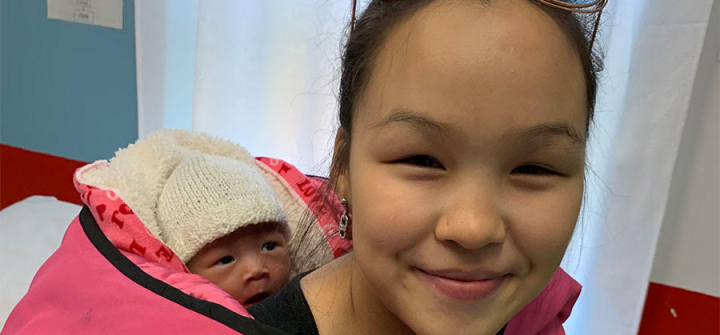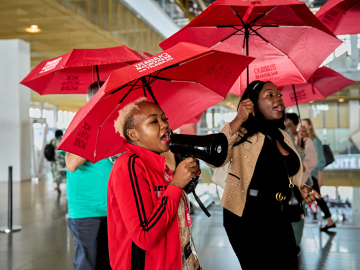The Midwives with Mettle in Nunavik
A newborn’s cries break the expectant stillness of the delivery room. Beaming beneath her surgical mask, midwife Kimberly Moorhouse lifts the baby to the new mother’s glistening face as the sun begins to crest over the Inukjuak midwifery center in Nunavik, a remote region in northern Quebec.
A few short decades ago, such scenes were not possible in Nunavik. Starting in the 1970s, in an attempt to reduce birth complications, the government’s national health service began sending women in the community south at 36 weeks gestation, to give birth in Moose Factory (a community in northern Ontario, ~515 miles away). With no family members for support and unreliable flight options to return home, Moorhouse explained, the women sometimes had to sit alone in Moose Factory for months.
Unsurprisingly, the women of Nunavik began to rebel, insisting there was no reason for them to go south. “People started refusing to leave the town to give birth, giving birth with a nurse at the local community health center instead,” Moorhouse says. For a population with such limited health resources, though, there was a clear need for specialized care locally—and the community mobilized to make a change. Thanks to the collective efforts of the Nunavimmiut, the Inuit inhabitants of the region, midwifery services were brought to Nunavik to help women give birth safely in their own communities. Now, Inuit midwives are leading the initiative—exemplifying the transformative power of Indigenous-led care.
The Inuultisvik Midwifery Service was created in 1986 in Puvirnituq and has since expanded to Inukjuak and Salluit, 2 other communities on the Hudson coast of Nunavik—allowing women with low-risk pregnancies to receive the majority of their prenatal care locally and deliver at a “maternity” under the care of midwives in Inukjuak, Salluit or Puvirnituq.
“In the beginning, it was the southern midwives (midwives trained outside of Nunuavik) who came here to teach Inuit women to become midwives,” explains Patrice Latka, a midwife from Toronto who has been working in Nunavik for years. “Now, because it’s been such a longstanding program, there are Inuit midwives who have been here for 15 years or longer. They are getting instructor qualifications and teaching the specialized skills, like neonatal resuscitation and emergency skills, that we used to come up here to teach.” The midwifery education program trains and certifies new midwives in Nunavik with full licenses under the Ordre des Sages-Femmes du Quebec, the province’s governing body for midwifery. Now, 11 registered, locally-trained midwives cover the communities on the Hudson coast of Nunavik.
As the only health care practitioners trained in Nunavik, the midwives hold an influential position in their community. “We gather prenatal and postnatal women in the community together for fetal alcohol syndrome prevention programs. We promote exclusive breastfeeding for 6 months, diabetes prevention, and good nutrition. We try to stop the spread of sexually transmitted infections by making it less taboo [to seek treatment],” Moorhouse explains.
Those services are especially important as Inuit infants experience significantly higher rates of perinatal morbidity and mortality compared to the rest of Canada, and even compared to other rural or northern populations. According to Margaret Mina, Moorhouse’s colleague at the Inukjuak midwifery, their efforts are helping. “Now, fewer young girls are getting pregnant because we offer contraception counseling. We are making a change.”
The success of the Nunavik midwifery program has garnered international recognition, too; it has become a model that is being implemented in other parts of the world, such as Australia’s ‘Birthing on Country’ models launched in 2013. “All of the prenatal care, all of the intrapartum care, all of the postpartum care is provided by Inuit midwives. This is what needs to be happening in all Indigenous communities,” says Latka.
Nunavik’s young might not even realize how dramatically things have improved, Moorhouse notes. The first babies the midwifery service helped are growing up and having their own babies, ushered into the world surrounded by community elders, grandmothers, aunts, sisters, partners and friends.
The return of births to Nunavik had also sparked a healing process for the families and communities affected by policies such as the evacuation of pregnant women to Moose Factory, Moorhouse reports. “There’s less trauma, less violence, and there’s more bonding with the children because fathers can be present for the birth. It strengthens the relationship and changes the family dynamic.”
But then, the COVID-19 pandemic hit—threatening to unwind all of the progress.
Editors’ Note: This is the first article in a 2-part series; see part II, When COVID-19 Hit, The Midwives of Nunavik Delivered, here.
Miriam Gladstone is a 2020 Pulitzer Center Campus Consortium Reporting Fellow and a second year student at the McGill University School of Medicine in Montreal. She also holds a Masters of Science in Reproductive and Sexual Health Research from the London School of Hygiene.
Join the 50,000+ subscribers in 170+ countries who rely on Global Health NOW summaries and exclusive articles for the latest public health news. Sign up for our free weekday enewsletter, and please share the link with friends and colleagues: https://www.globalhealthnow.org/subscribe
A mother and her newborn who was delivered at the Inukjuak Maternity amidst rising COVID-19 restriction in Nunavik, Quebec, September 2020. Image by Patrice Latka.




